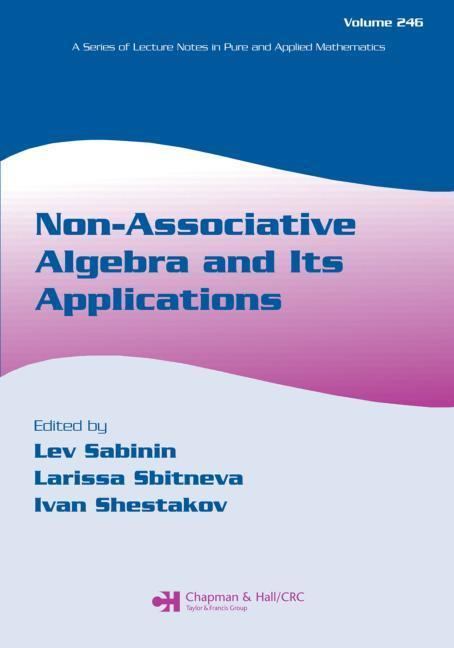 | ||
Non associative algebra
A non-associative algebra (or distributive algebra) is an algebra over a field where the binary multiplication operation is not assumed to be associative. That is, an algebraic structure A is a non-associative algebra over a field K if it is a vector space over K and is equipped with a K-bilinear binary multiplication operation A × A → A which may or may not be associative. Examples include Lie algebras, Jordan algebras, the octonions, and three-dimensional Euclidian space equipped with the cross product operation. Since it is not assumed that the multiplication is associative, using parentheses to indicate the order of multiplications is necessary. For example, the expressions (ab)(cd), (a(bc))d and a(b(cd)) may all yield different answers.
Contents
- Non associative algebra
- Algebras satisfying identities
- Associator
- Examples
- Properties
- Free non associative algebra
- Associated algebras
- Derivation algebra
- Enveloping algebra
- References
While this use of non-associative means that associativity is not assumed, it does not mean that associativity is disallowed. In other words, "non-associative" means "not necessarily associative", just as "noncommutative" means "not necessarily commutative" for noncommutative rings.
An algebra is unital or unitary if it has an identity element I with Ix = x = xI for all x in the algebra. For example, the octonions are unital, but Lie algebras never are.
The nonassociative algebra structure of A may be studied by associating it with other associative algebras which are subalgebra of the full algebra of K-endomorphisms of A as a K-vector space. Two such are the derivation algebra and the (associative) enveloping algebra, the latter being in a sense "the smallest associative algebra containing A".
More generally, some authors consider the concept of a non-associative algebra over a commutative ring R: An R-module equipped with an R-bilinear binary multiplication operation. If a structure obeys all of the ring axioms apart from associativity (for example, any R-algebra), then it is naturally a
Algebras satisfying identities
Ring-like structures with two binary operations and no other restrictions are a broad class, one which is too general to study. For this reason, the best-known kinds of non-associative algebras satisfy identities which simplify multiplication somewhat. These include the following identities.
In the list, x, y and z denote arbitrary elements of an algebra.
These properties are related by
- associative implies alternative implies power associative;
- associative implies Jordan identity implies power associative;
- Each of the properties associative, commutative, anticommutative, Jordan identity, and Jacobi identity individually imply flexible.
- For a field with characteristic not two, being both commutative and anticommutative implies the algebra is just {0}.
Associator
The associator on A is the K-multilinear map
It measures the degree of nonassociativity of
The nucleus is the set of elements that associate with all others: that is, the n in A such that
Examples
More classes of algebras:
Properties
There are several properties that may be familiar from ring theory, or from associative algebras, which are not always true for non-associative algebras. Unlike the associative case, elements with a (two-sided) multiplicative inverse might also be a zero divisor. For example, all non-zero elements of the sedenions have a two-sided inverse, but some of them are also zero divisors.
Free non-associative algebra
The free non-associative algebra on a set X over a field K is defined as the algebra with basis consisting of all non-associative monomials, finite formal products of elements of X retaining parentheses. The product of monomials u, v is just (u)(v). The algebra is unital if one takes the empty product as a monomial.
Kurosh proved that every subalgebra of a free non-associative algebra is free.
Associated algebras
An algebra A over a field K is in particular a K-vector space and so one can consider the associative algebra EndK(A) of K-linear vector space endomorphism of A. We can associate to the algebra structure on A two subalgebras of EndK(A), the derivation algebra and the (associative) enveloping algebra.
Derivation algebra
A derivation on A is a map D with the property
The derivations on A form a subspace DerK(A) in EndK(A). The commutator of two derivations is again a derivation, so that the Lie bracket gives DerK(A) a structure of Lie algebra.
Enveloping algebra
There are linear maps L and R attached to each element a of an algebra A:
The associative enveloping algebra or multiplication algebra of A is the associative algebra generated by the left and right linear maps. The centroid of A is the centraliser of the enveloping algebra in the endomorphism algebra EndK(A). An algebra is central if its centroid consists of the K-scalar multiples of the identity.
Some of the possible identities satisfied by non-associative algebras may be conveniently expressed in terms of the linear maps:
The quadratic representation Q is defined by
or equivalently
The article on universal enveloping algebras describes the canonical construction of enveloping algebras, as well as the PBW-type theorems for them. For Lie algebras, such enveloping algebras have a universal property, which does not hold, in general, for non-associative algebras. The best-known example is, perhaps the Albert algebra, an exceptional Jordan algebra that is not enveloped by the canonical construction of the enveloping algebra for Jordan algebras.
